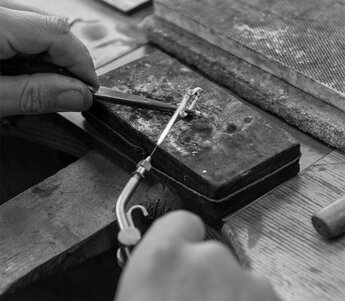Conflict Free Diamonds - Kimberley Process (KP) and Certified Diamond Trade
Transparent proof of the origin of our diamonds
We are committed to only selling diamonds from conflict-free sources. Since the founding of our shop we have insisted that our suppliers also provide us with a transparent proof of the origin of all diamonds. The same applies to our English website and we exclusively obtain all diamonds from conflict-free sources.

The HANDMADE-ENGAGEMENTRINGS.com promise of origin
- We only sell diamonds from conflict-free sources.
- In the so called "System of Warranties, (SoW)" our suppliers are obliged to prove the impeccable origin of all diamonds used.
- We strongly support the Kimberley Process established in the diamond industry to stop the trade of "conflict diamonds". This standard ensures that 99% of all diamonds traded worldwide are now conflict-free.
- Fairly mined diamonds create jobs. More than ten million people around the world are employed in the mining, refining and trade of diamonds. Schools, infrastructure and hospitals have been built on the African continent - financed by money earned in the diamond industry. When selecting our suppliers, we pay close attention to these social factors.
This is how the trade with verified conflict-free diamonds works:
According to the Kimberley Process, a blood or conflict diamond is a diamond that has been illegally extracted and whose sale is used to finance civil wars and other violent conflicts. It is currently being discussed whether this definition needs to be expanded in order to protect human rights and achieve an even more lasting effect.
Until the Kimberley Agreement was finally signed in 2002, the number of illegally mined diamonds grew steadily. In the 1990s, up to 4% of the diamonds traded worldwide were conflict diamonds, used by rebel groups, among others, to finance their bloody battles.
In the diamond industry, it gets more and more common to act against the trade of those conflict diamonds. Partly for business reasons, partly for moral and ethical reasons. Governments around the world joined the demands of the diamond industry, eventually leading to the ratification of the Kimberley Agreement on the 5th of November, 2002.
Today, 54 countries (the EU as a single country) and all African diamond producers have officially committed themselves to the Kimberley Process. Compliance with the criteria is monitored by the UN and implemented by governments, NGOs and the diamond industry.

Trade only with certificate of origin
Rough diamonds that are traded across national borders must be transported in tamper-resistant containers, accompanied by a certificate of origin issued by the state. They may only be delivered to countries that have signed the Kimberley Agreement. Imports into countries that have ratified the Kimberley Agreement without a valid certificate are prohibited. Participating countries are also obliged to carry out national controls to prevent illegal trade within the country.
The so-called "system of guarantees" also expects, that each supplier provides the recipient with written proof of the conflict-free source from which the supplied diamonds originate.
Conflict-free diamonds only at HANDMADE-ENGAGEMENTRINGS.com
HANDMADE-ENGAGEMENTRINGS.com and our manufacturers have an active dialogue with all participating diamond traders. This way we can ensure that the rules of the Kimberley Agreement are observed and that only conflict-free goods are being bought and sold through us.
Today it has been proven that more than 99% of the diamonds traded worldwide originate from conflict-free sources. Everyone involved is working hard to ensure that all diamonds in the future will be clean diamonds.
By participating in the system of guarantees, we can ensure our customers: With us you buy products with impeccable diamonds only.
Kimberley Process: A complete value chain - against child labour and exploitation
The two largest companies in the diamond industry, De Beers and Alrosa, produce over 75% of all rough diamonds worldwide. Around 150 selected partners of the mining companies - diamond cutters and traders (called sight holders) - process and sell the diamonds, e.g. to our workshop. Here the jewellery is made and finally sold to the jeweller or the end customer.

With the so-called Kimberley Agreement, all companies involved have committed themselves to documenting the path of each diamond using international standards and certificates of origin. Within this process there is no room for child labour or exploitation.
Impact of the Kimberley Process on the diamond trade
The Kimberley Process, launched in May 2000, is intended to prevent the trade in so-called blood diamonds through the certificates of origin, which are issued and controlled by the state. Blood diamonds are (raw) diamonds whose sale, finance armed conflicts.
Currently, 54 participants in the Kimberley Process, representing a total of 80 states, commit themselves to only trading diamonds, which are certified as conflict-free. The European Member States are involved in the Kimberley Process through the EU as a participant. The diamond industry and various NGOs (non-governmental organisations) are also represented in the Kimberley Process. The presidencies of the participating countries change annually.

How is the Kimberley Process being implemented ?
In order to become a participant in the Kimberley Process, states must meet minimum requirements. These include the implementation of the Kimberley Process regulations in national law and the establishment of control authorities. Among other things, these authorities carry out import, export and transit controls on diamond deliveries. In addition, the participating States have to provide statistical data for the purposes of the Kimberley Process.
The trade on rough diamonds may only take place between participating States and in compliance with the certification scheme. For shipments of rough diamonds, for example, a valid certificate must be available to certify that there is no conflict.
What are the current developments in the Kimberley Process?
Strict guidelines and monitoring measures by the participants have led to significant improvements in compliance in various mining areas. Some states in which diamonds are mined currently do not meet the necessary requirements and are therefore not allowed to export rough diamonds.
The Kimberley Process also aims to improve transparency in production, regulate mining and trade, prevent illegal trade and support miners.
Bestselling engagement rings
Our customers have decided: These are the most popular engagement rings.
5 good reasons
Do you just need a little push to order from us? We can help you with 5 good reasons!


